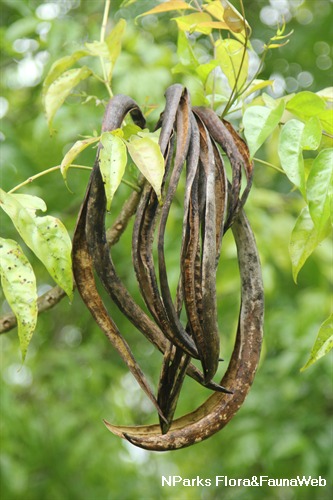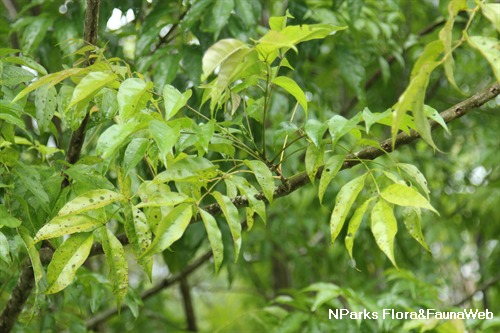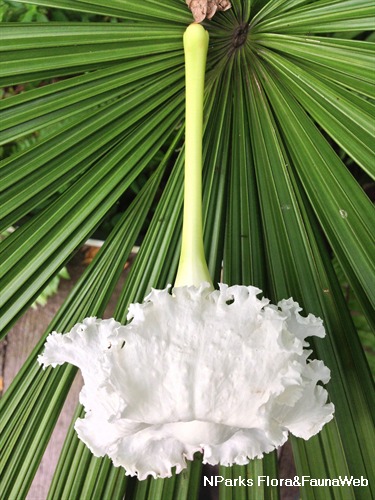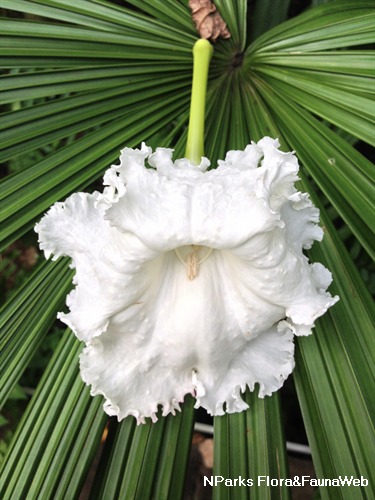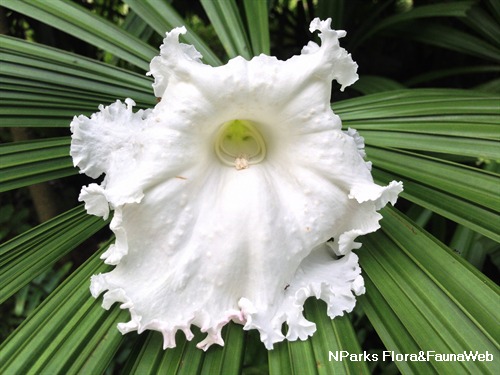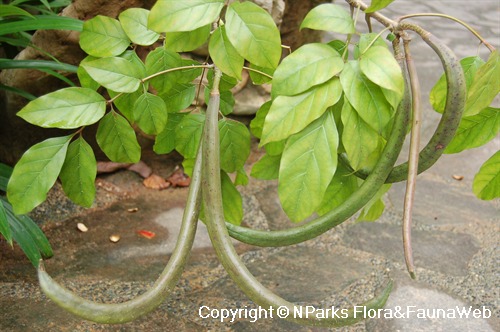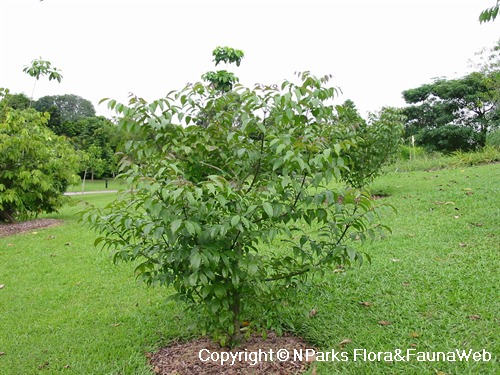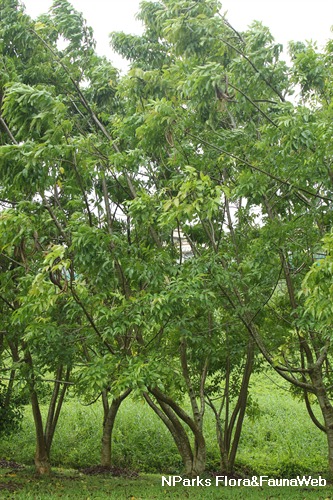
Back
Dolichandrone spathacea (L.f.) K.Schum.
| Family Name: | Bignoniaceae |
| Synonyms: | Bignonia spathacea L.f., Dolichandrone rheedii (Spreng.) Seem. |
| Common Name: | Mangrove Trumpet Tree, Tui, Tuai, Joran, 南亚猫尾木 |
Dolichandrone spathacea or Mangrove Trumpet Tree is a tree that grows to 25 m tall. It has compound leaves and large, white, trumpet-shaped flowers that opens at night. The flower composed of a long thin tube and spread out to 5 lobes with frilly edges. It produce bean-like fruit which spilt upon maturity, releasing buoyant, rectangular seeds with corky wings.
Name
Classifications and Characteristics
| Plant Division | Angiosperms (Flowering Seed Plants) (Dicotyledon) |
|---|---|
| Plant Growth Form | Tree (Medium (16m-30m)) |
| Lifespan (in Singapore) | Perennial |
| Mode of Nutrition | Autotrophic |
| Plant Shape | Irregular |
| Maximum Height | 25 m |
Biogeography
| Native Distribution | From India through Southeast Asia to New Caledonia |
|---|---|
| Native Habitat | Terrestrial (Coastal Forest), Shoreline (Mangrove Forest) |
| Preferred Climate Zone | Tropical, Sub-Tropical / Monsoonal |
| Local Conservation Status | Native to Singapore (Critically Endangered (CR)) |
Description and Ethnobotany
| Growth Form | It is a tree that can grow up to 25 m tall. |
|---|---|
| Trunk | The trunk has smooth, grey to dark brown coloured bark. |
| Foliage | Leaves are compound pinnate, often reddish when young, measuring 20 - 30 cm long, held on a reddish petiole of up to 6 cm. Leaflets are asymmetrical, broad egg-shaped to broad lance-shaped with smooth margins sometimes wavy. The terminal leaflet at the end of the leaf tends to be larger than rest of the lateral pairs. Each leaflet measures between 5.5–20 cm long by 2.5–7 cm wide. |
| Flowers | Flowers are borne on an inflorescence, each shoot contains 2 - 6 flowers, each measures at 15 - 20 cm long. Flowers are large, white, trumpet-shaped, composed of a long thin tube that expands near the opening and spreads abruptly into 5 rounded lobes with frilly edges. They are fragrant, nocturnal, dropping off at about sunrise. |
| Fruit | The fruit is a bean-like, splits upon maturity measuring 20–70 cm long by 1.5–3 cm wide. Seeds are buoyant, dark grey, rectangular with corky wings about 1.5cm long. |
| Habitat | Occurs in upper mangrove forests including the landward edge of such forests, banks of tidal rivers and estuaries. |
| Associated Fauna | Pollination is presumably by long-tongued nocturnal animals such as hawk moths. |
| Cultivation | It can be propagated by seed. |
| Etymology | Greek dolichos, long; Greek andron, male, referring to the long stamens of its flowers; Greek spathe, a broad leaf blade |
| Ethnobotanical Uses | Medicinal: A tea prepared from the leaves is thought to cure mouth diseases. Its leaves and fruits can be substitutes of betel leaves. Its seeds are given with ginger in cases of convulsive affections. Timber & Products: The timber is light and good for carving. The Javanese use the wood to make saddles, while the Filipinos use it to make wooden shoes and fishing net floats. In Indonesia, the wood is used to make traditional masks and also as firewood. |
Landscaping Features
| Landscaping | It is suitable for planting along roadsides or in coastal areas, as it can tolerate hot, sunny, high wind speed, and salt spray conditions. It can also tolerate waterlogged soil that is freshwater or brackish. |
|---|---|
| Desirable Plant Features | Ornamental Flowers, Ornamental Fruits, Fragrant |
| Landscape Uses | Coastal Plant, General, Suitable for Roadsides, Parks & Gardens, Small Gardens, Beachfront / Shoreline |
Fauna, Pollination and Dispersal
| Fauna Pollination Dispersal Associated Fauna | Moth Food Plant (Flower Nectar) |
|---|---|
| Pollination Method(s) | Biotic (Fauna) (Insects (Butterfly, Moth)) |
| Seed or Spore Dispersal | Abiotic (Water) |
Plant Care and Propagation
| Light Preference | Full Sun |
|---|---|
| Water Preference | Moderate Water, Lots of Water |
| Plant Growth Rate | Slow |
| Rootzone Tolerance | Moist Soils, Waterlogged Soils (Drains Site) |
| Maintenance Requirements | Moderate |
| Propagation Method | Seed |
Foliar
| Foliage Retention | Evergreen |
|---|---|
| Mature Foliage Colour(s) | Green |
| Prominent Young Flush Colour(s) | Red |
| Foliar Type | Compound (Odd-Pinnate) |
| Foliar Arrangement Along Stem | Opposite |
| Foliar Attachment to Stem | Petiolate |
| Foliar Shape(s) | Non-Palm Foliage (Lanceolate, Oblong, Ovate) |
| Foliar Venation | Pinnate / Net |
| Foliar Margin | Entire, Entire - Wavy / Undulate |
| Foliar Apex - Tip | Acuminate |
| Foliar Base | Acute, Rounded / Obtuse |
| Leaf Area Index (LAI) for Green Plot Ratio | 3.0 (Tree - Intermediate Canopy) |
Non - Foliar and Storage
| Stem Type & Modification | Woody |
|---|---|
| Root Type | Underground (Tap Root) |
Floral (Angiosperm)
| Flower & Plant Sexuality | Bisexual Flowers , Bisexual Flowers |
| Flower Colour(s) | White |
|---|
| Flower Grouping | Cluster / Inflorescence |
| Flower Location | Axillary |
| Flower Symmetry | Bilateral |
| Individual Flower Shape | Trumpet-shaped |
| Inflorescence Type | Raceme |
| Flowering Habit | Polycarpic |
Fruit, Seed and Spore
| Mature Fruit Colour(s) | Brown |
|---|---|
| Fruit Classification | Simple Fruit |
| Fruit Type | Dehiscent Dry Fruit , Legume / Pod |
References
| References | Santisuk, T. (1987). Bignoniaceae. Flora of Thailand. 5(1). Bangkok: The Forest Herbarium, Royal Forest Department. pp. 32-66. Tomlinson, P.B. (2016). Family: Bignoniaceae (eds) In: Tomlinson, P.B. The Botany of Mangroves, pp.215-219. Cornwall: Cambridge University Press. Yong, J., Tan, P.Y., Nor, H.H., Tan, S.N. (2010). A Selection of Plants for Greening of Waterways and Waterbodies in the Tropics. Singapore: Chung Printing. pp. 480 |
|---|
Image Repository
Others
| Master ID | 1566 |
|---|---|
| Species ID | 2859 |
| Flora Disclaimer | The information in this website has been compiled from reliable sources, such as reference works on medicinal plants. It is not a substitute for medical advice or treatment and NParks does not purport to provide any medical advice. Readers should always consult his/her physician before using or consuming a plant for medicinal purposes. |

